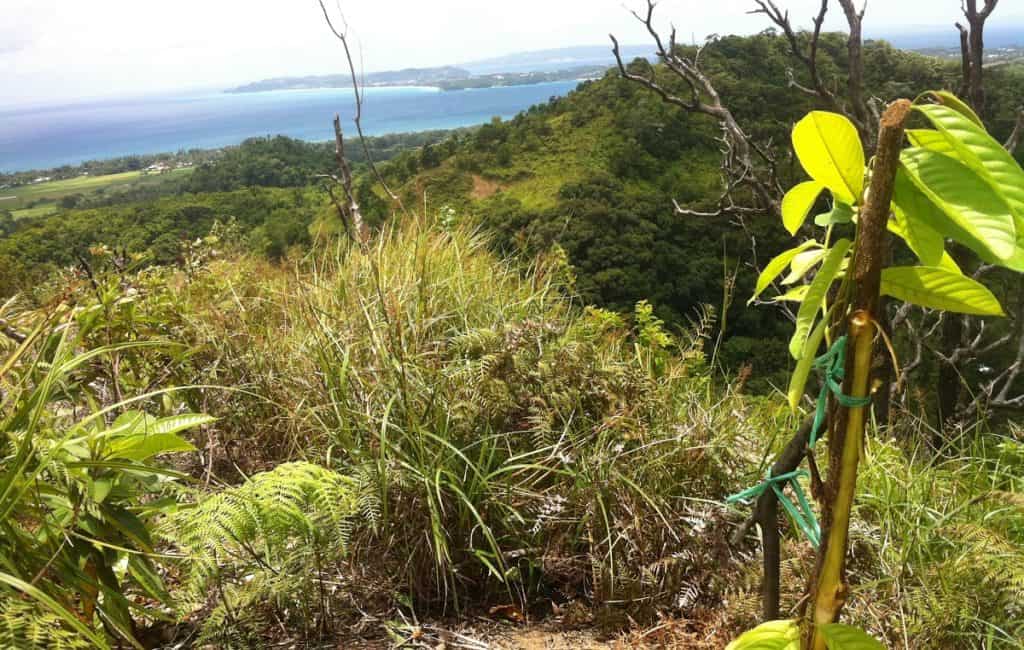Last Updated on June 8, 2023 by Ellen
422 fruit tree saplings are in the ground; staked, watered, some already sprouting new growth.
It happened in two separate somewhat frenzied planting sessions here near our temporary COVID home in Malay, Aklan, Panay, Philippines.
With the help of our overseas supporters, we provided the trees. But doing all the work – and reaping a modest economic reward – were indigenous Ati moms, kids, families.


That was one of the goals; involve the ladies and get a few Philippine pesos to some tribe members besides the dozens of men who have worked on the various other Ati projects we’ve sponsored.
Related: Ati get electricity, running water, egg-laying hens, new bridge
The other main goal: to replace the dozens of mature trees the Ati themselves have cut and converted (burned) into charcoal then sold for subsistence income during the coronavirus crisis.
Mission accomplished. Anyone planting a tree received 25 pesos (50 cents). And that was on top of the 10 pesos (20 cents) we paid to have each sapling carried up the mile-long mountain footpath to the planting areas.
In all, about $220 was distributed in the planting phase — after about $100 for carrying and temporary care. All the funds desperately needed by the Ati (and everyone here) as coronavirus lockdowns continue, the economy sputters, and vaccines have been given to just 10% of the Philippine population.
In fact, there was so much excitement for the Sunday morning planting event at the larger Ati hilltop settlement that things got away from me a little.


Ati tree tale
When I asked what time would be good to begin, it was agreed we would start after the 8:00 a.m. church service that some Ati attend at the cute rustic chapel seen above (one of my favorite Ati structures).
I said fine, I would hike up and conduct an instructional demonstration at 9:30 a.m. Surprisingly, when I arrived the planting was already in full swing. People spread out and digging everywhere – the Ati tribal chieftain loosely supervising.
It seems that the plan to attend Sunday services had been scrapped in favor of making some money ASAP. Perhaps I should have expected such.
Some of the saplings were planted too close together, others too exposed to hilltop winds, others not in enough sun. I had also lost track of some of the more valuable – and delicate – grafted trees.
Upon transplanting when needed, a few in-ground trees were even discovered to still have the plastic wrap encasing the root ball.
Sufferin’ saplings! That’s not gonna work.
In fairly short order I was able to redirect the effort, reclaim most of the grafted plants, and get the remaining 50% of this batch of 250 trees properly embedded.
By noontime the job was finished more or less to my satisfaction — the planters all pleased with their pesos.


Later, at the second more remote location, a smaller group of Ati families spent several hours putting another 170 small trees in the ground. The main difficulty this time – the terrain.
The area had actually been charred by a wildfire around the time of our arrival in March of 2020. We watched the nighttime orange sky-glow from our seaside apartment back then – before we had ever met the Ati.
Even now, the steep hills are sometimes sparse with vegetation, the ground sun-baked and hard charred. In the photo above, I have highlighted a few areas where small landslides have occurred.
Obviously, our saplings will be beneficial. And the second tree corps would not be deterred. While I sometimes struggled with my footing, Ati women and children expertly climbed and dug and planted the tender trees.
Success!
In the end, the fruit tree exercise was a success. Honestly, if half the trees survive long-term I will be thrilled. With rainy season upon us now, the saplings should have a decent chance.


Meanwhile, hopefully the planting program will help stabilize the land and Ati finances at this uncertain time.
Bigger picture, perhaps the few pesos earned today – and the edible fruit in the future – might cause the younger generation of Ati to view and value differently their trees and lands and environment and actions.
As always, be thankful and generous (like our overseas donors), happy trails & more beer.
Life is NOW!


Please re post how we can contribute.
Hi CA! Thank you!
Old link from last year – same methods —> https://www.earthvagabonds.com/ati-donations-will-go-a-long-way-in-malay-philippines/
Hope you are doing well.
Hugs and love from over here!